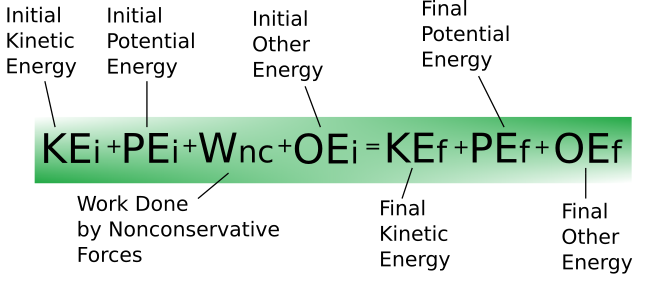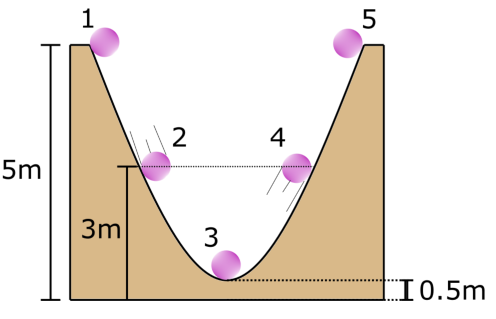What is conservation of energy?
Physics has discovered over the years that there are several forms of energy. These energies can be transferred from one system to another in certain ways. This conclusion leads to two main energy types; mechanical energy, which is a total of kinetic (KE) and potential energy (PE); and the energy transferred through work done by neoconservative forces, Wnc.
Energy can neither be created nor destroyed. It can just be transformed from one form into another."
We can see the conservation of energy in our everyday lives. For instance, a generator converts mechanical energy into electrical energy. But for practical generators, there seems to always be a difference between the energy input and output. So if the energy is conserved, where does this lost energy go? In this instance, the 'lost' energy is mainly converted into unwanted thermal energy in the form of heat.
Solar panels are a great everyday example of energy forms transforming into each other, since the solar panels convert light energy from the sun into electrical energy.
You have learned that there are many forms of energy. We will study energy in the forms of kinetic energy, potential energy, and work done by nonconservative forces. Let's gather the rest in a group which we will call other energy, or OE.

The general equation for the conservation of energy. Tezcan - StudySmarter OriginalsWe are going to focus on circumstances where OE is constant, hence it will not be considered and will be subtracted out.
Even though it is out of the scope of this explanation, the group we call other energy OE, plays an important role in our daily lives. A great and common example of this is when we consume food. With the help of water, energy, and releasing CO2, the food is oxidised and results in chemical energy.
This chemical energy can convert into several different forms of energy. For instance, when you move, it is converted into kinetic energy and causes your body to warm up, which then is converted into thermal energy.
Forms of energy
We will discuss some of the main ones briefly, and we will study potential energy and kinetic energy in detail.
- Electrical energy is produced by the movement of electrically charged particles. It can be converted into many other types of energies such as mechanical energy or thermal energy and is used in a variety of applications.
- Nuclear energy results from certain amounts of mass converting into energy. It is converted into electrical energy in nuclear power plants, and is converted into radiant energy in stars. For instance, the sun converts nuclear energy into radiant energy (in this case, sunlight).
- Radiant energy is a result of electromagnetic radiation such as visible light, infrared, and ultraviolet radiation.
- Chemical energy can be transferred into other systems via oxidation. It is converted into electrical energy in batteries. It is the form of energy that fuels and food carry.
- Thermal energy is related to the temperature of a system or an object and it describes the internal mechanical energy of a system.
Potential and kinetic energy
You have learned that mechanical energy consists of two types of energy, potential and kinetic energy. When studying in ideal conditions where there is no mechanical energy loss due to friction or air resistance, you should always keep in mind that the initial mechanical energy will be equal to the final mechanical energy.
Mechanical energy is the energy an object possesses because of its motion and/or its position.
This means that potential and kinetic energy can be converted into each other, but in an ideal system, the sum of the two will be constant.
Kinetic energy is the energy an object with mass possesses because of its motion.
Kinetic energy Ek is measured in Joules. We can describe it mathematically by looking at its definition. We need to consider an object's mass (m) in kilograms, and the object's speed (v) in metres per second.
\[E_k = \frac{1}{2} \cdot m \cdot v^2\]
Potential energy on the other hand can be in two different forms; gravitational potential energy and elastic potential energy. The first one is the energy an object has because of its relative position to the gravitation source; or, for objects on Earth, height.
\[\Delta E_p = m \cdot g \cdot \Delta h\]
Where,
ΔEp is the change in gravitational potential energy in Joules.
m is the mass of the object in kilograms.
g is the gravitational field strength in N/kg.
Δh is the change in height in metres.
Elastic potential energy on the other hand is the energy stored in a system or an object because of stretching or compression. For instance, when you stretch a rubber band or compress a string, you use energy to do so. This energy is transferred into stored energy, or in this case elastic potential energy.
\[E = \frac{1}{2} \cdot k \cdot (\Delta L)^2\]
Where,
E is elastic potential energy in Joules.
k is the stiffness constant in N/m.
ΔL is the extension or compression of the object in metres.
In the figure below, the ball has a potential energy of 5.5 J and kinetic energy of 0 J when it is in position 1. The ball starts moving down the platform. Calculate the ball's kinetic and potential energies for positions 2, 3, 4, and 5.

A ball rolling down a platform with an ideal surface. Tezcan - StudySmarter Originals
Solution
No matter which position the ball is in, we know that the mechanical energy will be conserved. This means that the sum of potential and kinetic energy at any given position will be the same.
In this case, the ball has gravitational potential energy. Let's first have a look at position 1 to gather the ball's mass. We know that:
\(E_p = m \cdot g \cdot h\)
The gravitational field strength on the surface of the Earth is 9.81 Nkg-1. If we put the given values in the formula we get:
\(5.5 = m \cdot 9.81 \cdot 5\)
\(m = 112 g\)
Now that we know the mass of the ball, we can look at position 2. Since the ball has started moving downwards, its potential energy will decrease and transform into kinetic energy. Let's find its potential energy first.
\(E_{p2} = 0.112 \cdot 9.81 \cdot 3 = 3.30 J\)
Since we know that energy is conserved, we can subtract this energy value from the initial potential energy to find the value of kinetic energy.
\(E_{k2} = E_{p1} - E_{p2} = 5.5 - 3.3 = 2.2 J\)
In order to find the ball's speed at position 2, we will use the kinetic energy formula and put in the known variables.
\(E_{k2} = 2.2 J = \frac{1}{2} \cdot 0.112 \cdot v^2\)
\(v = 6.27 m/s\)
In position 3, since the height is at its minimum, the potential energy will also be at its minimum, hence the kinetic energy will be at its maximum value.
\(E_{p3} = 0.112 \cdot 9.81 \cdot 0.5 = 0.55 J\)
We can find the kinetic energy in position 3 by subtracting Ep3 from the initial potential energy Ep1.
\(E_{k3} = E_{p1} - E_{p3} = 5.5 - 0.55 = 4.95 J\)
In order to find the ball's speed at position 3, we will use the kinetic energy formula and put in the known variables.
\(E_{k3} = 4.95 J = \frac{1}{2} \cdot 0.112 \cdot v^2\)
\(v = 9.40 m/s\)
Now that we know the potential and kinetic energies and speeds at positions 1, 2, and 3, we don't have to calculate them for positions 4 and 5, since the height in these positions are equal to 2 and 1 respectively.
\(E_{k4} = E_{k2} = 2.2 J \quad E_{k5} = E_{k1} = 0J \quad E_{p4} = E_{p2} = 3.30 J \quad E_{p5} = E_{p1} = 5.5 J\)
In the previous example, we have looked at an ideal system with no friction and air resistance. Hence the ball will keep on moving and it will reach the same height at both ends every time. But if we try this experiment at home we will observe that the ball comes to a stop eventually. This doesn't mean that the energy is not conserved. Rather, it means that there is air resistance, and friction of the surface is apparent. The mechanical energy transforms into other types of energies because of these external forces. So the total energy of the system is conserved.
Efficiency
When it comes to energy conservation, one of the most important terms is efficiency (η). Although the energy is conserved in any system, it can transform into other unwanted energy types in the process. This is why the output energy is always less than the input energy in real-life examples.
We can define efficiency mathematically as below.
\[\eta = \frac{\text{Useful energy or work output}}{\text{Total energy input}} = \frac{W_{out}}{E_{in}}\]
In practice, the value of efficiency can't be equal to or higher than 1. This is because there are always external forces apparent in every system that cause the input energy to transform into less useful energy forms. We can state efficiency as a percentage by multiplying the efficiency result by a hundred.
\[\eta_{\%} = \frac{W_{out}}{E_{in}} \cdot 100\]
Conservation of Energy - Key takeaways









